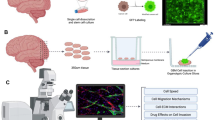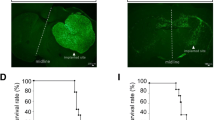Abstract
Purpose. The primary cause of local recurrence and therapeutic failure in the treatment of malignant gliomas is the invasion of tumor cells into the surrounding normal brain. While it is known that malignant gliomas infiltrate diffusely into regions of normal brain, it is frequently very difficult to unequivocally identify the solitary invading glioma cell in histopathological preparations, or in experimental glioma models. We have developed an experimental invasion assay system, which allows us to track the solitary invasive glioma cell, using human brain tissue obtained from routine craniotomies for seizures or trauma.
Methods. This tissue is cut into 1-mm thick slices and cultured in the upper chamber of Transwell culture dishes on top of a 0.4-µm pore size polyester membrane, which is fed on medium provided in the lower chamber. Glioma cells are stably transfected with vectors containing a green fluorescent protein (GFP) cDNA. Stable, high-level expression GFP transfectants were selected by direct visualization under fluorescence microscope. In addition, various tumor spheroids are stained with vital dye, DiI, to track the invading cells. GFP-expressing glioma cells or stained spheroids were then implanted on the center of the brain slice, and the degree of brain tumor invasion into the brain tissue was evaluated at different time points by optical sectioning using a confocal microscope.
Results. We observed that GFP-expressing glioma cells or stained spheroids could be readily tracked and followed with this model system. Individual tumor cells that exhibited green or red fluorescence could be identified and their migration path through the brain slices unequivocally followed.
Conclusion. This experimental invasion system may be of considerable utility in studying the process of brain tumor invasion and in evaluating its invasiveness in individual brain tumor because it not only provides a better representation of extracellular matrix molecules normally encountered by invading glioma cells, but also provides the fluorescent tag applied to the tumor cells.
Similar content being viewed by others
Author information
Authors and Affiliations
Additional information
Electronic Publication
Rights and permissions
About this article
Cite this article
Jung, S., Kim, HW., Lee, JH. et al. Brain tumor invasion model system using organotypic brain-slice culture as an alternative to in vivo model. J Cancer Res Clin Oncol 128, 469–476 (2002). https://doi.org/10.1007/s00432-002-0366-x
Received:
Accepted:
Issue Date:
DOI: https://doi.org/10.1007/s00432-002-0366-x




